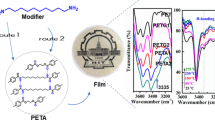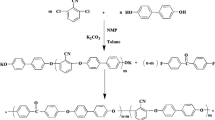Abstract
Poly(oxyethylene)diamines were included in the copolymerization of ethylene glycol and dicarboxylic acids, such as terephthalic, adipic and sebacic acid, to produce a series of hydrophilic polyether-ester-amides. With the addition of poly(oxyethylene)diamines (average molecular weight of 2,000) to PET in the amounts of 3.2, 6.6, 12 and 16 wt%, melting points of these polymers dropped accordingly, from 240 °C to around 227 °C, and the electronic resistivity decreased from 1×1013 to approximately 8×108 ohm/sq. For comparison, the introduction of hydrophilic PEG-2000 or a low molecular weight diamine, such as triethyleneglycol diamine, has less effect on electronic resistivity. Molecular weight, polymer rigidity and ageing are other factors affecting the surface resistivity. The degree of hydrophilicity was measured by the moisture absorption of the fibers made from these polyether-ester-amides. A weight gain of 0.96% was observed for 12 wt% poly(oxyethylene)diamine modified polyether-ester-amides in comparison with 0.40% for the unmodified polyethylene terephthalate). These results are explained by a mechanism involving moisture absorption on the polymer surface through the formation of hydrogen bonding with amide and-(OCH2CH2)-functionalities on the polymer surface.
Similar content being viewed by others
References
I. Piirma, Polymeric Surfactant, Surfactant Science Series 34, Marcel Dekker, Inc., 1992.
Polymer Electrolyte Reviews 1 and 2, J. R MacCallum and C. A. Vincent Ed., Elsevier Applied Science, London, 1987 and 1989.
Electrochemical Science and Technology of Polymers 1, R. G. Linford Ed., Elsevier Applied Science, London, 1987.
Application of Electroactive Polymers, B. Scrosati Ed., Chapman & Hall, London, 1993.
Poly(Ethylene Glycol) Chemistry: Biotechnical and Biomedical Applications, J. M. Harris Ed., Plenum Press, New York, 1992.
Nonionic Surfactants-Polyoxyalkylene Block Copolymers, V. M. Nace Ed., Marcel Dekker, Inc., 1996.
A. T. Hu, R. S. Tsai and Y. D. Lee, J. of Appl. Polym. Sci., 37, 1863 (1989).
G. P. Speranza and C. S. Henkee, U. S. Pat. 5,324,812 (1993).
C. Yang and J. F. Rathman, Polymer, 37, 4621 (1996).
D. E. Fenton, J. M. Parker and P. V. Wright, Polymer, 14, 589 (1973).
R. Gachter and H. Muller, Plastics Additives Handbook, Hanser Publishers, Munich Vienna New York, 1984.
L. V. Interrante, L. A. Casper, and A. B. Ellis, Materials Chemistry, An Emerging Discipline, Advances in Chemistry Series 245 by The American Chemical Society Publishers Ltd, 1995.
B. Lee, U. S. Pat. 5,237,009 (1993).
M. Y. Young and J. J. Lin, Ind. Eng. Chem. Res., 37, 4284 (1998).
K. Okazaki, A. Nakagawa and K. Sugii, U. S. Pat. 3,558,419 (1971).
E. Gosselink and F. Diehl, E. P. Pat. No. 24198A2 (1987).
H. E. Wixon, E. P. Pat. No. 456569A1 (1991).
D. K. Gilding and A. M. Reed, Polymer, 20, 1454 (1979).
T. Fukumoto, K. Yano and M. Iwamoto, U. S. Pat. 5,096,995 (1992).
Author information
Authors and Affiliations
Corresponding author
Rights and permissions
About this article
Cite this article
Lin, J.J., Sheen, Y.C., Tseng, F.P. et al. Synthesis, characterization and electrostatic dissipating ability of poly(oxyethylene) block polyesteramides. J Polym Res 6, 243–250 (1999). https://doi.org/10.1007/s10965-006-0094-z
Issue Date:
DOI: https://doi.org/10.1007/s10965-006-0094-z




